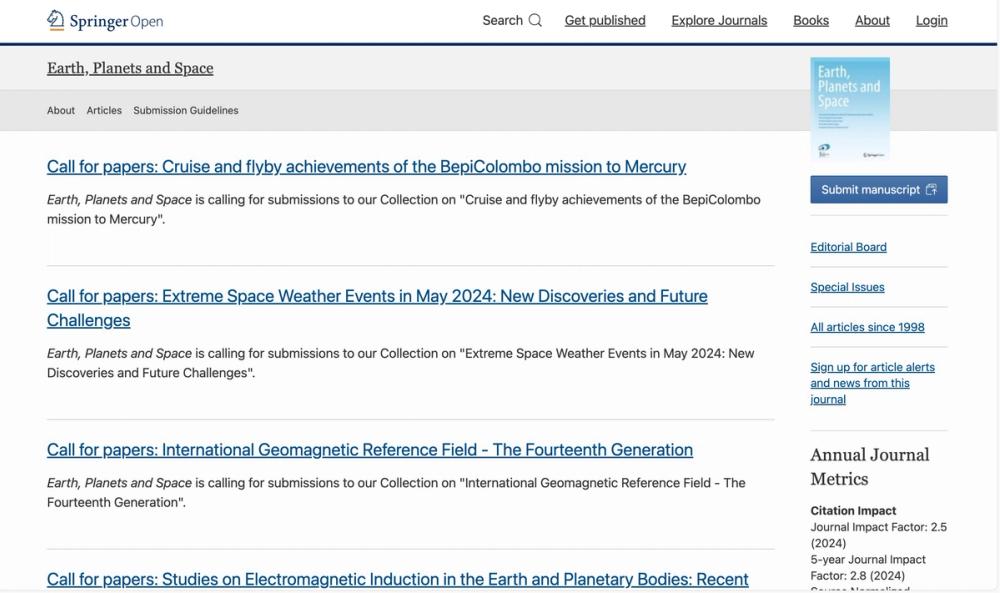Earth, Planets and Space
Link
earth-planets-space.springeropen.com
Description
Earth, Planets and Space (EPS) is a peer-reviewed, open-access journal publishing high-quality research in Earth and planetary sciences, focusing on geomagnetism, seismology, and interdisciplinary studies.
Key Words
peer-reviewed, open-access, Earth sciences, planetary sciences, geomagnetism, seismology, volcanology, geodesy, space science, interdisciplinary
Introduction
Earth, Planets and Space (EPS) is an international, peer-reviewed, open-access e-journal published by SpringerOpen in collaboration with five Japanese learned societies: the Society of Geomagnetism and Earth, Planetary and Space Sciences, the Seismological Society of Japan, the Volcanological Society of Japan, the Geodetic Society of Japan, and the Japanese Society for Planetary Sciences. Established in 1949 as the Journal of Geomagnetism and Geoelectricity and renamed in 1998 after merging with the Journal of Physics of the Earth (founded in 1952), EPS has grown into a prominent platform for disseminating cutting-edge research in Earth and planetary sciences.
The journal specializes in disciplines such as geomagnetism, aeronomy, space science, seismology, volcanology, geodesy, and planetary science, while also welcoming contributions in emerging and interdisciplinary fields, including new instrumentation. EPS publishes a variety of article types, including Full Papers, Express Letters for rapid publication of high-impact results, Frontier Letters (by invitation from the Editor-in-Chief), Technical Reports, and Comments, ensuring a broad spectrum of research dissemination. Only original, high-quality content is considered for publication, with a strict policy against review papers to maintain focus on novel findings.
EPS is committed to open-access principles, making all articles freely accessible online immediately upon publication without subscription barriers. Authors retain copyright, granting third parties the right to use and share their work under a CC BY license, which enhances global dissemination and impact. The journal’s article processing charge (APC) for 2025 is £1020.00/$1640.00/€1330.00, with discounts available for Express Letters and waivers for authors from low-income countries or those with financial need.
With a 2024 Journal Impact Factor of 2.5 and a 5-year Impact Factor of 2.8, EPS ranks in the Q1 quartile for Geology and Q2 for Space and Planetary Science, reflecting its scientific influence (SCImago Journal Rank: 0.773). Its citation performance, with an h-index of 96, underscores its role in advancing research, particularly in seismology, geodesy, geophysics, and Earth’s magnetic field studies. The journal’s interdisciplinary scope also covers topics like ionosphere research, computational physics, and magnetospheric phenomena, fostering connections across related fields.
EPS supports special issues on topics like extreme space weather, geomagnetic reference fields, and volcanic activity, with submission deadlines extending into 2025. The journal’s editorial process is efficient, with a median of 14 days to first editorial decision and 153 days to acceptance, ensuring timely publication. Back issues from 1998 to 2013 are accessible via SpringerLink and TERRAPUB, while earlier volumes, including its predecessor journals, are archived in the National Diet Library and J-STAGE.
By providing a platform for rigorous, innovative research, EPS continues to contribute significantly to the global scientific community, bridging traditional and emerging disciplines in Earth and planetary sciences.




